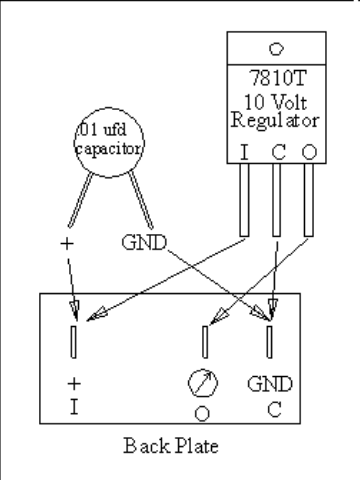
This is supposed to work on all 140/164 1973-1975 and all 240/260 1975-1980. Earlier 140/164 uses about 5.1 volts.....
This device regulates the average voltage to 10 volts by operating in a manner similar to the blinker switch that controls your directional and hazard lights. A bimetallic strip is heated by an electric wire coiled around it, causing it to bend and open a switch. This system has a characteristic time constant associated with it that varies with the voltage applied to it. This switch opens and closes about 2 times a second, cutting power to the gauge when it opens, supplying power when it closes. The same damping that causes the gauge needles to fall slowly when you cut the ignition makes this on again/off again action invisible to the viewer.
The voltage when it is closed multiplied by the percentage of a second that it is closed equals approximately 10 Volts. Since the voltage of a cars electrical system varies all of the time depending on what accessories are on, the charge of the battery, condition of the charging system, etc., this gives a steady baseline from which the gauges can measure the voltage across the sending units. When this stabilizer fails, it behaves erratically, producing some other voltage and thus, causing the gauges to give faulty readings.
Now while this part is not difficult to replace, there is a way to save some money and at the same time move ahead into the age of transistor radios and solid state televisions. This mechanical regulator system, while clever and reliable, is archaic. An inexpensive high tech device will do the trick!
What you need: a 10 volt regulator (P/N 7810T) and a .01 microfarad capacitor (P/N .01UF). You should be able to get these parts at any electronics supplier. Then unplug the old regulator, gently open the case by bending back the lip with a needle nose pliers, and remove the old mechanical innards while preserving the integrity of the fiber base plate. In about five to ten minutes you should have soldered the electronic pieces in and plugged it back into the dash!
The fiber base plate is marked with a '+', '-' and an arrow. The '+' is the electrical system input, the '-' is the vehicle ground, and the arrow is the stabilizer output. The regulator has three pins: Input, Common and Output looking from left to right across the bottom. Connect the regulator and the base plate by soldering single strand wire from the regulator Input to the baseplate '+', the regulator Common to the baseplate '-', and the regulator Output to the baseplate output terminal. Finish by soldering the capacitor between the input and ground terminals (this insulates the regulator from transient input signals). Leave the case cover off of the baseplate to maximize cooling of the regulator. Finally, wrap the capacitor and the 'hot' leads with electrical tape to prevent a short with a grounded piece behind the dashboard.
